Related Research Articles

701 Naval Air Squadron was a Royal Navy Fleet Air Arm squadron, which last disbanded during September 1958 at RNAS Lee-on-Solent where it was a Helicopter Trials, Communications and Fleet Requirements Unit. It initially formed during July 1936 as a Catapult Flight operating out of Malta and routinely embarking in RN ships such as, HMS Barham, HMS Malaya, HMS Valiant and HMS Warspite. By autumn 1939 it was known as 701 Naval Air Squadron but disbanded in January 1940. It was active twice more during the Second World War, between May 1940 and June 1941 on special duties and then between October 1942 and August 1943 performing anti-submarine patrols. Reforming in April 1945 it was designated a Communications Unit, operating out of Heston until disbanding in 1947. It last reformed as a Fleet Requirements Unit at HMS Daedalus, Lee-on-Solent, during October 1957.

792 Naval Air Squadron was a Naval Air Squadron of the Royal Navy's Fleet Air Arm and was originally formed at RNAS St Merryn in August 1940 as an Air Target Unit, equipped with six Blackburn Skuas. The squadron disbanded in 1945 and merged with 794 Naval Air Squadron. 792 Squadron reformed at RNAS Culdrose in 1948 as a Night Fighter Training Unit. It was initially equipped with Fairey Firefly NF.1s and Avro Ansons. They were later replaced with Sea Hornets shortly before the squadron disbanded again in August 1950.

707 Naval Air Squadron was a Naval Air Squadron of the Royal Navy's Fleet Air Arm which disbanded during February 1995. It was active during the Second World War forming during February 1945 as a Radar Trials Unit, disbanding in October of the same year. It reformed December 1964, as an Advanced and Operational Flying Training Commando helicopter squadron.

711 Naval Air Squadron was a Naval Air Squadron of the Royal Navy's Fleet Air Arm which disbanded in December 1945. It was first formed from 447 (Catapult) Flight in 1936 and operated out of the Island of Malta, providing flights for the Royal Navy’s 1st Cruiser Squadron. By the beginning of World War II it had become a Squadron and was based in Egypt, but disbanded in 1940 when the Fleet Air Arm centralised the operations of the 700 series "Catapult" flights attached to catapult units. It reformed in September 1944 to provide torpedo bomber reconnaissance (TBR) training. Based at HMS Jackdaw in Fife, Scotland, it was operational for just over one year before it was absorbed by 785 Naval Air Squadron.

715 Naval Air Squadron was a Naval air squadron of the Royal Navy Fleet Air Arm created on 15 July 1936 to serve as a catapult flight of the Fleet Air Arm of the RAF. It was elevated to squadron status at the end of 1937, before being disbanded on 21 January 1940. It was re-formed on 17 August 1944 to operate as the Fighter Wing of the School of Air Combat, before being disbanded for good on 31 March 1946, and absorbed into 736 Naval Air Squadron.
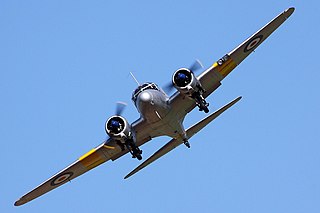
720 Naval Air Squadron was a Naval Air Squadron of the Royal Navy's Fleet Air Arm. The squadron originated as the Catapult Fight for the New Zealand Division and it achieved squadron status and a shore base at Auckland, New Zealand, before the start of the Second World War. However it was absorbed into 700 Naval Air Squadron in January 1940. The squadron reformed at the beginning of August 1945, from an unnumbered photographic flight originally formed in December 1940, at HMS Peregrine, RNAS Ford, in Sussex, as the RN Photographic Squadron. It moved to HMS Siskin, RNAS Gosport, in Hampshire, during May 1948, but 720 Naval Air Squadron disbanded in January 1950, with 771 Naval Air Squadron taking on the aircraft and duties.
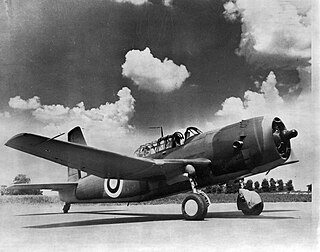
721 Naval Air Squadron was a Naval Air Squadron of the Royal Navy's Fleet Air Arm (FAA). 721 Naval Air Squadron formed at HMS Gadwall, RNAS Belfast, Northern Ireland, at the beginning of March 1945, as a Fleet Requirements Unit for the British Pacific Fleet. Initially equipped with Vultee Vengeance target tugs, it arrived at HMS Nabaron, RNAS Ponam, Admiralty Islands in May 1945, and commenced operations towing targets. The squadron moved to HMS Nabsford, RNAMY Archerfield, Brisbane, Australia, during October and then relocated to Hong Kong at the beginning of 1946, moving to HMS Nabcatcher, RNAS Kai Tak, where it eventually disbanded at the end of 1947.

722 Naval Air Squadron was a Naval Air Squadron of the Royal Navy's Fleet Air Arm (FAA) created on 7th September 1944, as a Fleet Requirements Unit, where it was responsible for assisting in ship and aircraft gunnery practice. On 24 October 1945 the squadron disbanded following the end of the Second World War.
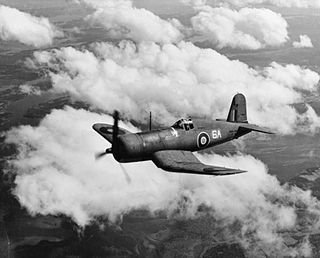
732 Naval Air Squadron was a Naval Air Squadron of the Royal Navy's Fleet Air Arm (FAA). It was initially formed in 1943 from a requirement for an Operational Training Unit for United States trained FAA pilots flying Vought Corsair fighter-bomber aircraft, at RN Air Section Brunswick, USNAS Brunswick, Maine, United States, and disbanded during 1944. In 1945 it was reformed for a brief period, as a Night Fighter Training Squadron, operating out of HMS Nighhawk, RNAS Drem, East Lothian, Scotland. Notably equipped with six Avro Anson 'flying classrooms', amongst other aircraft.
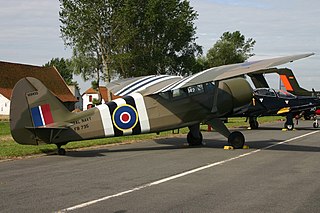
740 Naval Air Squadron was a Naval Air Squadron of the Royal Navy's Fleet Air Arm. It was initially active between May and August in 1943, formed as an Observer Training Squadron at HMS Condor, RNAS Arbroath, Angus, Scotland. From December 1943 to September 1945 it was a Communications Squadron formed at and operated from HMS Landrail, at RNAS Machrihanish, Argyll and Bute, Scotland.

742 Naval Air Squadron was a Naval Air Squadron of the Royal Navy's Fleet Air Arm which disbanded during August 1946. It was active initially from the end of 1943 as a Communications Squadron operating in Sri Lanka and India. It later became a Royal Navy Air Transport Squadron, covering the same geography.
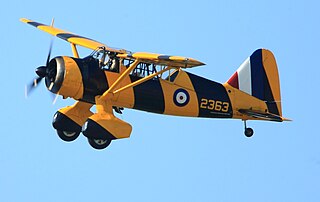
754 Naval Air Squadron was a Naval Air Squadron of the Royal Navy's Fleet Air Arm. It was active as an Observer Training Squadron from 1939 to 1944 as part of No. 2 Observer School, forming out of the School of Naval Co-operation RAF, in May 1939. It initially operated out of HMS Daedalus, RNAS Lee-on-Solent, Hampshire, however, after the Naval Air Station was attacked and bombed, it then moved to north to HMS Condor, RNAS Arbroath, Angus, Scotland, in September 1940. Here, it provided training for Observers and also Air Gunners and where four years later, in March 1944, it disbanded. The squadron then briefly reformed as a Air Gunner Training Squadron, as part of No. 1 Naval Air Gunners School, when 744 Naval Air Squadron was re-designated 754 Naval Air Squadron, in June 1944, at RN Air Section Yarmouth, Nova Scotia, Canada, until disbanding again, in March 1945.

775 Naval Air Squadron was a Naval Air Squadron of the Royal Navy's Fleet Air Arm which last disbanded in March 1946. 775 Naval Air Squadron formed at HMS Grebe, RNAS Dekheila, during November 1940, as a Fleet Requirements Unit in support of the Mediterranean Fleet, based at Alexandria, Egypt. Between October 1941 and March 1942 the squadron also included the RN Fighter Flight. It absorbed 728 Naval Air Squadron in July 1943 and moved to R.N.Air Section Gibraltar at the start of February 1944. The squadron returned to HMS Grebe, RNAS Dekheila during August 1945.

780 Naval Air Squadron was a Naval Air Squadron of the Royal Navy's Fleet Air Arm which last disbanded at HMS Seahawk, RNAS Culdrose in November 1949. 780 Naval Air Squadron formed at HMS Raven, RNAS Eastleigh as a Conversion Course Unit, in October 1939, to train experienced civilian pilots in naval flying. It moved to HMS Daedalus, RNAS Lee-on-Solent, in October 1940, and later, its role had changed to converting pilots to Fairey Barracuda aircraft. It spent a year at RNAS Charlton Horethorne, before returning to HMS Daedalus and disbanded, early 1945. In March 1946, the squadron reformed at HMS Godwit, RNAS Hinstock, as the Naval Advanced Flying School, to give flying instructors' courses, and later provided Instrument Flying Training. In December, the squadron moved to HMS Jackdaw, RNAS Crail, then in March 1947 moved to HMS Merlin, RNAS Donibristle, and in May to HMS Seahawk as the first resident unit.

784 Naval Air Squadron was a Naval Air Squadron of the Royal Navy's Fleet Air Arm which last disbanded in the autumn of 1946. 784 NAS was a Night Fighter Training Squadron which formed at HMS Daedalus, RNAS Lee-on-Solent, Hampshire, in June 1942, moving to HMS Nighthawk, RNAS Drem, East Lothian, in October 1942. Squadron Personnel were also detached to the Naval Air Radio Installation Unit at RAF Christchurch, in 1943 and in the same year, a number of crews were attached to RAF night fighter squadrons, with two officers gained Distinguished Flying Crosses. In 1944, three squadron Flights were attached for service to each of 813, 825 and 835 Naval Air Squadrons, embarked in the escort carriers HMS Campania, HMS Vindex, and HMS Nairana respectively, on convoy protection duties. At the beginning of 1946 the squadron moved to Wales, operating out of HMS Goldcrest II, RNAS Brawdy.

788 Naval Air Squadron was a Naval Air Squadron of the Royal Navy's Fleet Air Arm which last disbanded during June 1945. The squadron formed at RN Air Section China Bay in Ceylon, in January 1942, as the British Eastern Fleet's Torpedo Bomber Reconnaissance Pool, however it lost half its strength during the heavy raids by Japanese carrier-borne aircraft in the April. The squadron regrouped at RNAS Tanga in Tanganyika, East Africa to become a Fleet Requirements Unit and relocating almost immediately to RN Air Section Port Reitz, in Mombasa, where it remained operational for the next three years.

795 Naval Air Squadron was a Naval Air Squadron of the Royal Navy's Fleet Air Arm which last disbanded at RNAS Ford, in Sussex, during March 1947. Originally formed as the Eastern Fleet Fighter Pool at RNAS Tanga, in Tanganyika, in June 1942, it’s 'A' Flight's supported the invasion of Madagascar, from HMS Illustrious, before being detached at Majunga on anti-submarine patrols as part of the Royal Air Force’s No. 207 Group. The squadron later moved to RNAS Mackinnon Road, in Kenya, before disbanding during August 1943. It reformed as a Refresher Training Squadron at RNAS Eglinton, in Northern Ireland, in August 1946 as part of the Fleet Air Arm’s 52nd Training Air Group and later included a couple of deployments in HMS Implacable.
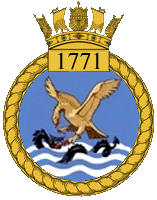
1771 Naval Air Squadron was a Naval Air Squadron of the Royal Navy's Fleet Air Arm which disbanded at HMS Nabbington, RNAS Nowra, near Sydney, in October 1945. Notably, the squadron was the first British & Commonwealth unit to fly over Japan in the Second World War. The squadron formed at HMS Heron, RNAS Yeovilton at the start of February 1944, as a Fighter Squadron and also operated from HMS Ringtail, RNAS Burscough, and HMS Landrail, RNAS Machrihanish, with deck landing training on the escort carriers HMS Trumpeter and HMS Ravager before embarking in the fleet carrier HMS Implacable in September. It was involved in sorties over Norway including reconnaisance of the German battleship Tirpitz and other anti-shipping strikes. The squadron remained in HMS Implacable and joined the British Pacific Fleet participating in attacks on the Caroline islands and the Japanese home islands, and becoming part of the 8th Carrier Air Group.
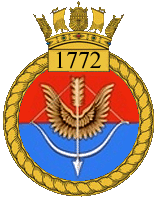
1772 Naval Air Squadron was a Naval Air Squadron of the Royal Navy's Fleet Air Arm (FAA), which last disbanded, at Portsmouth, in March 1946. The squadron formed at HMS Ringtail, RNAS Burscough as a Fighter Squadron during May 1944. It joined HMS Ruler for passage to Australia leaving January 1945 and disembarking at HMS Nabstock, RNAS Schofields, mid-March. The squadron embarked in HMS Indefatigable in July, joining the British Pacific Fleet for attacks againgst the Japanese home islands. After the end of the Second World War it dropped supplies on PoW camps.
References
Citations
- ↑ Wragg 2019, p. 244.
- 1 2 Ballance, Howard & Sturtivant 2016, p. 427.
- ↑ "Royal Navy Ship's Batle Honours". Royal Navy Research Archive - Battle Honours of RN ships & Naval Air Squadrons. Retrieved 14 May 2024.
- ↑ Ballance, Howard & Sturtivant 2016, p. 427&428.
- ↑ Wragg 2019, p. 244-246.
Bibliography
- Ballance, Theo; Howard, Lee; Sturtivant, Ray (2016). The Squadrons and Units of the Fleet Air Arm. Air Britain Historians Limited. ISBN 978-0-85130-489-2.
- Wragg, David (2019). The Fleet Air Arm Handbook 1939-1945. Cheltenham, Gloucestershire, UK: The History Press. ISBN 978-0-7509-9303-6.